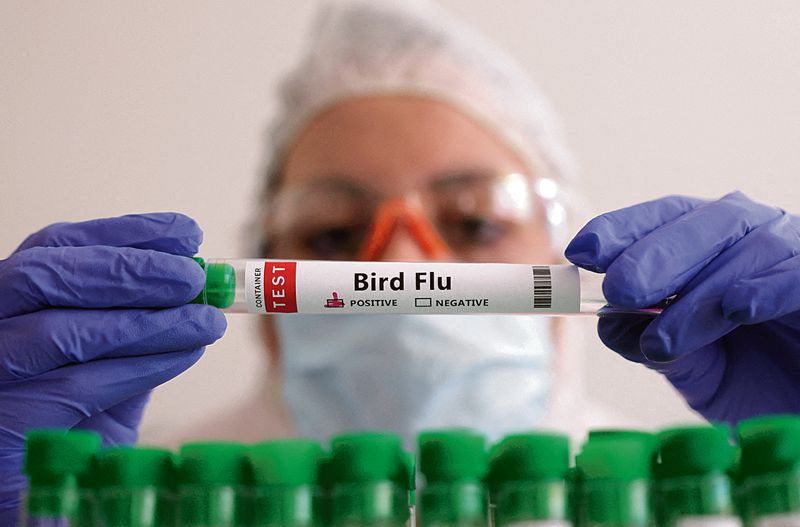
Concern: Bird flu has been spreading across the world for over a year. Reuters
TK Arun
Senior Journalist
The World Health Organisation has expressed concern over the death of an 11-year-old girl in Cambodia last month after contracting bird flu, which has been spreading across large parts of the world for more than a year. Even more troubling has been the fact that her father tested positive for the bird flu virus, indicating the possibility of human-to-human transmission of the disease. Earlier, mink and sea lions had contracted the disease in different parts of the world after eating infected birds, establishing a bird-to-mammal transmission.
Argentina has announced a ban on the export of chicken from that country after finding the disease among its industrial poultry. Chicks have suddenly become expensive in China as a result of the present and anticipated shortages following mass culling of infected birds across the world.
This raises the possibility that another zoonotic pandemic is just a few virus mutations away. The Covid-causing coronavirus originally lived only among bats. Zoonosis is, of course, the transmission of a disease from animal species to humans. As humans transgress traditional boundaries that separated the habitats of wild animals from those of humans, and climate change destroys traditional habitats of both humans and wild creatures, forcing them to migrate, the risk of new varieties of zoonosis increases. Globalised interdependence causes zoonotic infections to cross borders and spread across the world with unprecedented rapidity. But for the transcontinental deployment of soldiers from afar in World War I and their return home with infection, the Spanish flu would have been a localised affair in Europe. It ended up killing around two crore people in India at a time when India’s population was about 26 crore.
How does the world prepare for a pandemic that might cause mass destruction or not materialise at all? Bodies such as the Coalition for Epidemic Preparedness Innovations (CEPI) exist. The CEPI’s mission is to find a vaccine for a new pandemic threat within 100 days. It works on the basis of fund commitments from various countries. This arrangement leaves room for discomfort. As we know from the experience of climate commitments by rich nations, promises come forth more readily than cold cash. And even if enough funding materialises for financing the research and development costs of new vaccines and anti-viral drugs that work against mutant germs, their mass production and distribution remain a challenge that has to be financed.
One way is to set up another PM Cares Fund — with wholly opaque spending patterns justified in the name of speed and administrative convenience, donations to which are eligible for exemptions from income tax, 42 per cent of which belongs, by way of Finance Commission devolutions, to state governments that are denied both funds and any accountability as to how the money taken from them is spent.
A better way is to use risk transfer mechanisms that are a part and parcel of modern finance. The first task is to develop vaccines and techniques to store them at room or refrigerator temperatures rather than at 70 degrees Celsius below zero, as required by the Pfizer-BioNTech vaccine for Covid-19, and prepare the infrastructure for scaling up vaccine production. A body can be set up, ideally a coalition of medical research outfits, vaccine makers and drug companies. Its funding needs can be mobilised using social impact bonds, in which impact investors put in money and are repaid by the government if the intended outcome materialises.
Why involve impact investors if the government has to pay for the outcome in any case? Impact investors will bring in discipline to the choice of the personnel who constitute the agency charged with the development work and to its working and help generate faster results.
The government can set up another fund to meet the expense on large-scale procurement of vaccines and drugs and their deployment, in case the pandemic materialises. The money for this can be raised through pandemic bonds on the lines of catastrophe bonds used to insure against natural calamities. These short-term bonds offer higher than normal yields to compensate for the risk of the capital being repaid only in part or not at all, depending on whether the catastrophe in question materialises. If the pandemic strikes, the investors in the bonds might not be repaid at all, but if it does not, the additional expenditure for the government would be limited to the interest payment on the bonds. That would be an insurance premium well worth paying. In the process, the pandemic would be prepared for, and the populace would not suffer the panic and devastation that Covid engendered.
If the initial vaccine development generates intellectual property, the development agency would be well within its rights to lay claim to a share of it. It could be licensed to vaccine makers in other countries at minimal or zero cost, privileging conquest of the pandemic over private profit. With mass vaccination, even if each vial of vaccine generates only a tiny return as intellectual property income, the total volume of vaccines would generate a decent corpus that could fund preparation for the next vaccine.
India has some advantages in this regard that most other developing countries lack. Thanks to an oft-criticised decision in the early years of Independence to fund enclaves of excellence in higher education, even as basic education spread only poorly, India has the human resources to carry out research at the cutting edge in multiple disciplines that have to come together in tackling a challenge like the pandemic, even if all of these resources are not located in India. As a lower middle-income country, the cost of labour is low. Yet, as a multi-trillion-dollar economy, India has the ability to mobilise large chunks of capital to bring to bear on solving any specific problem.
If such advantages are married to modern risk transfer mechanisms, it would be possible for India to be fully prepared when the next pandemic strikes.
Join Whatsapp Channel of The Tribune for latest updates.




























